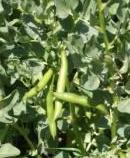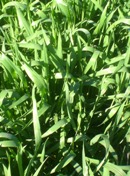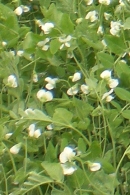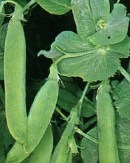Organic Farming
Organic farming is a form of agriculture that relies on crop rotation, green manure, compost, biological pest control, and mechanical cultivation to maintain soil productivity and control pests, excluding or strictly limiting the use of synthetic fertilizers and synthetic pesticides, plant growth regulators, livestock feed additives, and genetically modified organisms.
Fava Beans | Forerunner™ Triticale | Wheat (Yamhill)
Frostmaster Winter Peas | Forage Peas | Oats
 Fava Beans
Fava Beans
Fava beans are also used as a cover crop to protect delicate soil, because they grow quickly and produce a great deal of lush foliage. In addition, like most legumes, fava beans are nitrogen fixers, and they replenish the soil with this vital nutrient. Many farmers plant fava beans and plow them back into the field after the growth has peaked for mulch.
Back to Top
 Forerunner™Triticale
Forerunner™Triticale
Forerunner™ Triticale is an awnless variety. It can grow to heights of 50 to 60 inches. Early root growth and the ability to tie-up excess nitrogen and phosphorous makes it an excellent cover crop. Works very well following manure applications. Forerunner™ Triticale is a PVP variety.
Back to Top
 Wheat (Yamhill)
Wheat (Yamhill)
Yamhill Wheat is a soft white winter wheat that is awnless. Good for forage, covercrop, or grain.
Back to Top
 FrostMaster Winter Peas
FrostMaster Winter Peas
FrostMaster Winter Peas are long vined winter pea. It is a Forage type pea with good winter hardiness. It has the ability to produce more biomass compared to Austrian Winter Peas, also FrostMaster Peas are much sweeter than AWP, thus making it a much more desirable forage. Winter peas are very good fixers of nitrogen.
Back to Top
 Forage Peas
Forage Peas
Forage peas are a valuable source of forage protein. They are highly palatable with good digestibility. Peas are a suitable grazing alternative in the late summer when grass is in short supply. Forage peas are often used in Europe and other temperate areas such as north-central US to increase forage yield and/or improve the nutritional quality of the forage. They can also be grown at higher altitudes in the tropics and as a cool-season winter crop in some regions where maize or soybeans would be the summer crop. They are an excellent choice for the organic farmer looking to supply a bulky, protein-rich forage for their livestock.
Back to Top
 Oats
Oats
Oats are sown in the spring, as soon as the soil can be worked. An early start is crucial to good yields as oats will go dormant during the summer heat. Oats are cold-tolerant and will be unaffected by late frosts or snow. Typically about 100 kg/hectare (about 2 bushels per acre) are sown, either broadcast or drilled in 150 mm (6 inch) rows. Lower rates are used when underseeding with a legume. Somewhat higher rates can be used on the best soils with some varieties. Excessive sowing rates will lead to problems with lodging and may reduce yields with some varieties.

